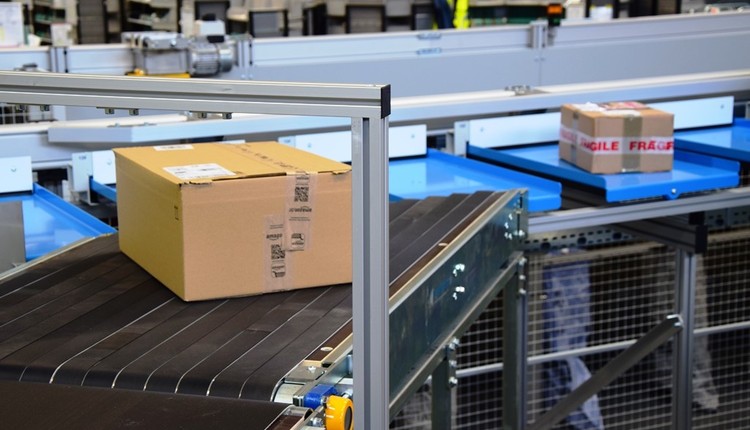N.J., facility, completing a project that will provide a significant portion of the building's peak energy needs. The installation is the first in a series of investments planned by UPS to increase the company's reliance on renewable energy.
The 250 kilowatt (kW) solar power system in New Jersey is expected to produce 270,000 kW hours of electricity annually, providing nearly 30% of the building's annual energy needs. The solar installation also reduces the facility's dependence on the local electric grid. UPS is assessing other facilities now to gauge their suitability for solar installations.
"UPS is always investigating new and innovative ways to power and improve the efficiency of its facilities that also demonstrate a meaningful return on investment," said Scott Wicker, chief sustainability officer. "Clean, renewable energy is just one of the ways we operate more efficiently."
The Lakewood installation was custom-designed and will be owned and operated by UPS in contrast to many solar projects that are owned and managed by third parties. This owner-operator approach saves engineering and construction costs.
The 70,000-square-foot Lakewood facility uses a system consisting of 1,036 solar panels, or 62,160 individual photovoltaic cells, installed on the facility's roof space. The facility harnesses light from the sun during the day, feeding the power into the public energy grid. At night, when the package sorting operations take place, UPS consumes energy from the grid. UPS took advantage of New Jersey's net metering rules, which offer compensation for generating excess power during the day and selling it back to the utility.
"The nature of our operation means we use most of our energy at night, so during the day much of the electricity produced by this system will flow back to the grid to support the utilities peak," said Wicker. "At night, when we're sorting the packages, we will draw from the grid the energy needed to power the facility."
The New Jersey solar facility and an existing UPS solar facility in Palm Springs, Calif., together offer significant environmental benefits based on a projected annual reduction of 161 metric tons of CO2 emissions. That's the equivalent of:
Taking nearly 32 cars off the road annually.
Not consuming 374 barrels of oil.
Saving 18,049 gallons of gas.
Providing electricity for nearly 20 households.
In addition to the solar facilities in California and New Jersey, the facility at the UPS Regional Air Hub at the Cologne-Bonn airport in Germany has its own rooftop solar farm, commissioned and operated by the airport. The farm produces up to 1.2 million kWh of electricity.
The 250 kilowatt (kW) solar power system in New Jersey is expected to produce 270,000 kW hours of electricity annually, providing nearly 30% of the building's annual energy needs. The solar installation also reduces the facility's dependence on the local electric grid. UPS is assessing other facilities now to gauge their suitability for solar installations.
"UPS is always investigating new and innovative ways to power and improve the efficiency of its facilities that also demonstrate a meaningful return on investment," said Scott Wicker, chief sustainability officer. "Clean, renewable energy is just one of the ways we operate more efficiently."
The Lakewood installation was custom-designed and will be owned and operated by UPS in contrast to many solar projects that are owned and managed by third parties. This owner-operator approach saves engineering and construction costs.
The 70,000-square-foot Lakewood facility uses a system consisting of 1,036 solar panels, or 62,160 individual photovoltaic cells, installed on the facility's roof space. The facility harnesses light from the sun during the day, feeding the power into the public energy grid. At night, when the package sorting operations take place, UPS consumes energy from the grid. UPS took advantage of New Jersey's net metering rules, which offer compensation for generating excess power during the day and selling it back to the utility.
"The nature of our operation means we use most of our energy at night, so during the day much of the electricity produced by this system will flow back to the grid to support the utilities peak," said Wicker. "At night, when we're sorting the packages, we will draw from the grid the energy needed to power the facility."
The New Jersey solar facility and an existing UPS solar facility in Palm Springs, Calif., together offer significant environmental benefits based on a projected annual reduction of 161 metric tons of CO2 emissions. That's the equivalent of:
Taking nearly 32 cars off the road annually.
Not consuming 374 barrels of oil.
Saving 18,049 gallons of gas.
Providing electricity for nearly 20 households.
In addition to the solar facilities in California and New Jersey, the facility at the UPS Regional Air Hub at the Cologne-Bonn airport in Germany has its own rooftop solar farm, commissioned and operated by the airport. The farm produces up to 1.2 million kWh of electricity.



